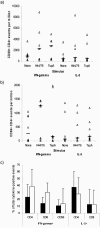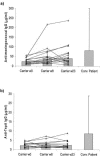T-cell-stimulating protein A elicits immune responses during meningococcal carriage and human disease
- PMID: 16040981
- PMCID: PMC1201220
- DOI: 10.1128/IAI.73.8.4684-4693.2005
T-cell-stimulating protein A elicits immune responses during meningococcal carriage and human disease
Abstract
In recognition of the need for immunological memory-inducing components for future Neisseria meningitidis group B vaccines, we previously searched the proteome of N. meningitidis and identified T-cell-stimulating protein A (TspA). This study was designed to confirm the immunogencity of TspA and to examine the subset of T-helper cell responses to the protein in patients and nasopharyngeal carriers. The tspA gene was reconstructed, cloned, and expressed in Escherichia coli, and the recombinant TspA (rTspA) protein was affinity purified. T-cell proliferative responses to rTspA were detected in the peripheral blood mononuclear cells (PBMCs) of convalescent patients and carriers, confirming that TspA-specific T-cell responses were stimulated by invasive disease and nasopharyngeal colonization. Following stimulation of PBMCs with meningococcal lysate, increased frequencies of both Th1 and Th2 cells were observed, indicating that, as during carriage, invasive meningococcal disease induced an unbiased T-helper subset response. A similar unbiased T-helper response was also detected against rTspA in the PBMCs of convalescent patients. The response of PBMCs from the carriers to TspA stimulation, however, was very weak, and the frequencies of cytokine-positive CD4 cells were not significantly greater than the frequencies in unstimulated control cultures. All of the patients and carriers responded with serum antimeningococcal immunoglobulin G (IgG) antibodies, while four of six samples from patients and 5 of 14 samples from carriers contained detectable anti-rTspA IgG antibodies. Taken together, the results of this study confirmed the immunogenicity of TspA in humans during natural meningococcal infection, and therefore, TspA is worthy of further investigation as a possible T-cell stimulating component of future vaccines.
Figures





References
-
- Abdel Hadi, H., K. G. Wooldridge, K. Robinson, and D. A. A. Ala'Aldeen. 2001. Identification and characterization of App: an immunogenic autotransporter protein of Neisseria meningitidis. Mol. Microbiol. 41:611-624. - PubMed
-
- Ala'Aldeen, D. A., and S. P. Borriello. 1996. The meningococcal transferrin-binding proteins 1 and 2 are both surface exposed and generate bactericidal antibodies capable of killing homologous and heterologous strains. Vaccine 14:49-53. - PubMed
-
- Andrade, M. A., C. Perez-Iratxeta, and C. P. Ponting. 2001. Protein repeats: structures, functions, and evolution. J. Struct. Biol. 134:117-131. - PubMed
-
- Bateman, A., and M. Bycroft. 2000. The structure of a LysM domain from E. coli membrane-bound lytic murein transglycosylase D (MltD). J. Mol. Biol. 299:1113-1119. - PubMed
-
- Bjune, G., E. A. Hoiby, J. K. Gronnesby, O. Arnesen, J. H. Fredriksen, A. Halstensen, E. Holten, A. K. Lindbak, H. Nokleby, E. Rosenqvist, et al. 1991. Effect of outer membrane vesicle vaccine against group B meningococcal disease in Norway. Lancet 338:1093-1096. - PubMed
Publication types
MeSH terms
Substances
LinkOut - more resources
Full Text Sources
Other Literature Sources
Medical
Research Materials

